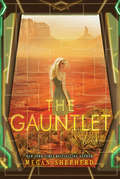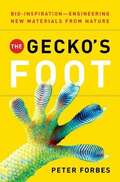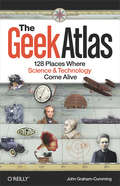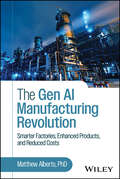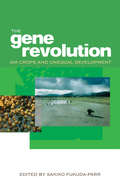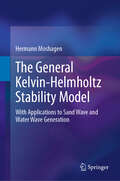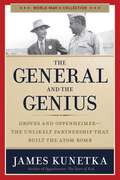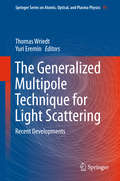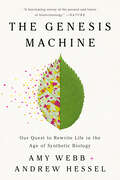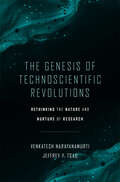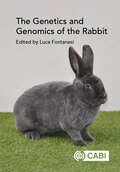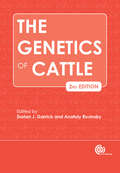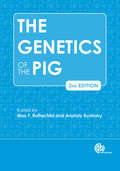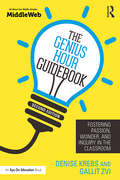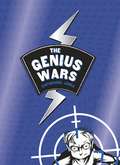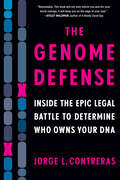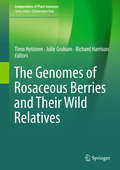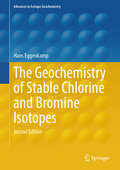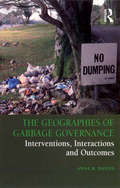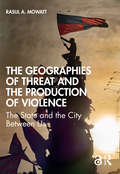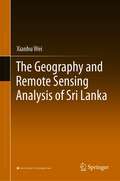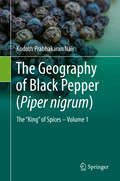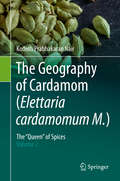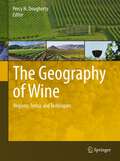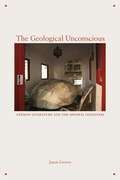- Table View
- List View
The Gauntlet
by Megan ShepherdPerfect for fans of Scott Westerfeld and The Maze Runner, The Gauntlet is the gripping finale to the thrilling and addictive Cage series about teens abducted from Earth by an otherworldly race—from Megan Shepherd, the New York Times bestselling author of the Madman’s Daughter series. Cora and her friends have escaped the Kindred station and landed at Armstrong—a supposed safe haven on a small moon—where they plan to regroup and figure out how to win the Gauntlet, the challenging competition to prove humanity’s intelligence and set them free. But Armstrong is no paradise; ruled by a power-hungry sheriff, it’s a violent world where the teens are enslaved and put to work in mines. As Nok’s due date grows closer, and Mali and Leon journey across space to rescue Cassian, the former inhabitants of the cage are up against impossible odds.With the whole universe at stake, Cora will do whatever it takes, including pushing her body and mind to the breaking point, to escape Armstrong and run the Gauntlet. But it isn’t just a deranged sheriff she has to overcome: the other intelligent species—the Axion, Kindred, Gatherers, and Mosca—all have their own reasons to stop her. Not knowing who to trust, Cora must rely on her own instincts to win the competition, which could change the world—though it might destroy her in the process.
The Gecko's Foot: Bio-inspiration, Engineering New Materials from Nature
by Peter ForbesArising from a series of articles he wrote for The Guardian aimed at a serious-minded general audience, this book explores topics of materials science and nanotechnology, and new understandings of nature. Forbes is inspired by the subject and he draws together a significant amount of technical and scientific information.
The Geek Atlas: 128 Places Where Science and Technology Come Alive
by John Graham-CummingThe history of science is all around us, if you know where to look. With this unique traveler's guide, you'll learn about 128 destinations around the world where discoveries in science, mathematics, or technology occurred or is happening now. Travel to Munich to see the world's largest science museum, watch Foucault's pendulum swinging in Paris, ponder a descendant of Newton's apple tree at Trinity College, Cambridge, and more.Each site in The Geek Atlas focuses on discoveries or inventions, and includes information about the people and the science behind them. Full of interesting photos and illustrations, the book is organized geographically by country (by state within the U.S.), complete with latitudes and longitudes for GPS devices. Destinations include:Bletchley Park in the UK, where the Enigma code was brokenThe Alan Turing Memorial in Manchester, EnglandThe Horn Antenna in New Jersey, where the Big Bang theory was confirmedThe National Cryptologic Museum in Fort Meade, MarylandThe Trinity Test Site in New Mexico, where the first atomic bomb was explodedThe Joint Genome Institute in Walnut Creek, CaliforniaYou won't find tedious, third-rate museums, or a tacky plaque stuck to a wall stating that "Professor X slept here." Every site in this book has real scientific, mathematical, or technological interest -- places guaranteed to make every geek's heart pound a little faster. Plan a trip with The Geek Atlas and make your own discoveries along the way.
The Gen AI Manufacturing Revolution: Smarter Factories, Enhanced Products, and Reduced Costs
by Matthew AlbertsTransformative insights and advice to reduce downtime, navigate disruptions, and improve efficiency The Gen AI Manufacturing Revolution highlights how generative and agentic artificial intelligence are transforming manufacturing processes, driving innovation, and reshaping the way we work. Implementing AI in manufacturing comes with unique challenges, such as integrating AI with physical machinery, managing intricate supply chains, and ensuring regulatory compliance. This book addresses these challenges, helping you harness AI's potential while navigating its complexities. With tailored strategies and use cases, the book demonstrates how to unlock the power of Gen AI, from automating routine tasks to enabling better decision-making. You'll learn to build an AI-ready workforce, overcome common challenges in adoption, drive value across the organization, and maintain accountability. Leverage generative AI to streamline product design, boost creativity, and accelerate innovation Deploy agentic AI systems to autonomously manage workflows, monitor performance, and support complex decision-making Build an AI-ready workforce capable of collaborating with intelligent systems Address ethical, operational, and cultural challenges in AI adoption Drive enterprise-wide value while maintaining transparency and accountability Whether you're looking to reduce downtime, enhance efficiency, or stay ahead of disruptive change, this book is your essential guide to leading the next wave of industrial transformation through AI.
The Gene Revolution: GM Crops and Unequal Development
by Sakiko Fukuda-ParrWhether or not to embrace GM technologies is a fundamental and politically charged question facing humanity in the 21st century, particularly in light of rapidly growing populations and the unknown future impacts of climate change. The Gene Revolution is the first book to bridge the gap between the ?naysayers? and ?cheerleaders? and look at the issues and complexities facing developing and transitional countries over decisions about GM in light of the reality of what is happening on the ground. The first part of the volume looks at the rise of GM crops, commercialization and spread of the technology and the different positions of the USA and the European Union on the GM question and the effect of global markets. The second part consists of country perspectives from Argentina, Brazil, China, India and South Africa, which provide insight into the profound challenges these countries face and the hard choices that have to be made. The final part takes the analysis a step further by comparing developing and transitional country experiences, and charts a future course for government policy on GM that supports growth, sustainability and equity for the many billions of people affected worldwide.
The General Kelvin-Helmholtz Stability Model: With Applications to Sand Wave and Water Wave Generation
by Hermann MoshagenThis book presents a generalized version of the classical Kelvin-Helmholtz instability, a useful tool which allows for new approaches when studying stability problems in fluid mechanics, as well as its important applications. It begins by providing an introduction to hydrodynamic stability and the Kelvin-Helmholtz (KH) instability. The author then develops the general KH stability model for a multi-layer flow system, which includes the conventional KH instability as a special case. This book also includes the detailed discussion of two important applications of this model: the generation of sand waves in alluvial channels and the generation of wind waves on water. Additionally, the effects of nonlinearities and the use of computational methods to study KH instability are included. This book serves as a concise and modern treatment of the KH stability model with specific attention paid to hydrodynamic stability analysis. It is ideal for graduate students interested in fluid dynamics as well as scientists and engineers in the fields of oceanography, geophysics, offshore engineering, and more.
The General and the Genius: Groves and Oppenheimer ? The Unlikely Partnership that Built the Atom Bomb
by James KunetkaTwo ambitious men. One historic mission. With a blinding flash in the New Mexico desert in the summer of 1945, the world was changed forever. The bomb that ushered in the atomic age was the product of one of history's most improbable partnerships. The General and the Genius reveals how two extraordinary men pulled off the greatest scientific feat of the twentieth century. Leslie Richard Groves of the Army Corps of Engineers, who had made his name by building the Pentagon in record time and under budget, was made overlord of the impossibly vast scientific enterprise known as the Manhattan Project. His mission: to beat the Nazis to the atomic bomb. So he turned to the nation's preeminent theoretical physicist, J. Robert Oppenheimer--the chain-smoking, martini-quaffing son of wealthy Jewish immigrants, whose background was riddled with communist associations--Groves's opposite in nearly every respect. In their three-year collaboration, the iron-willed general and the visionary scientist led a brilliant team in a secret mountaintop lab and built the fearsome weapons that ended the war but introduced the human race to unimaginable new terrors. And at the heart of this most momentous work of World War II is the story of two extraordinary men--the general and the genius.
The Generalized Multipole Technique for Light Scattering: Recent Developments (Springer Series on Atomic, Optical, and Plasma Physics #99)
by Thomas Wriedt Yuri EreminThis book presents the Generalized Multipole Technique as a fast and powerful theoretical and computation tool to simulate light scattering by nonspherical particles. It also demonstrates the considerable potential of the method. In recent years, the concept has been applied in new fields, such as simulation of electron energy loss spectroscopy and has been used to extend other methods, like the null-field method, making it more widely applicable. The authors discuss particular implementations of the GMT methods, such as the Discrete Sources Method (DSM), Multiple Multipole Program (MMP), the Method of Auxiliary Sources (MAS), the Filamentary Current Method (FCM), the Method of Fictitious Sources (MFS) and the Null-Field Method with Discrete Sources (NFM-DS). The Generalized Multipole Technique is a surface-based method to find the solution of a boundary-value problem for a given differential equation by expanding the fields in terms of fundamental or other singular solutions of this equation. The amplitudes of these fundamental solutions are determined from the boundary condition at the particle surface. Electromagnetic and light scattering by particles or systems of particles has been the subject of intense research in various scientific and engineering fields, including astronomy, optics, meteorology, remote sensing, optical particle sizing and electromagnetics, which has led to the development of a large number of modelling methods based on the Generalized Multipole Technique for quantitative evaluation of electromagnetic scattering by particles of various shapes and compositions. The book describes these methods in detail.
The Genesis Machine: Our Quest to Rewrite Life in the Age of Synthetic Biology
by Amy Webb Andrew HesselNamed one of The New Yorker's BEST BOOKS OF 2022 SO FARThe next frontier in technology is inside our own bodies. Synthetic biology will revolutionize how we define family, how we identify disease and treat aging, where we make our homes, and how we nourish ourselves. This fast-growing field—which uses computers to modify or rewrite genetic code—has created revolutionary, groundbreaking solutions such as the mRNA COVID vaccines, IVF, and lab-grown hamburger that tastes like the real thing. It gives us options to deal with existential threats: climate change, food insecurity, and access to fuel. But there are significant risks. Who should decide how to engineer living organisms? Whether engineered organisms should be planted, farmed, and released into the wild? Should there be limits to human enhancements? What cyber-biological risks are looming? Could a future biological war, using engineered organisms, cause a mass extinction event? Amy Webb and Andrew Hessel&’s riveting examination of synthetic biology and the bioeconomy provide the background for thinking through the upcoming risks and moral dilemmas posed by redesigning life, as well as the vast opportunities waiting for us on the horizon.
The Genesis of Technoscientific Revolutions: Rethinking the Nature and Nurture of Research
by Venkatesh Narayanamurti Jeffrey Y. TsaoResearch powers innovation and technoscientific advance, but it is due for a rethink, one consistent with its deeply holistic nature, requiring deeply human nurturing. Research is a deeply human endeavor that must be nurtured to achieve its full potential. As with tending a garden, care must be taken to organize, plant, feed, and weed—and the manner in which this nurturing is done must be consistent with the nature of what is being nurtured. In The Genesis of Technoscientific Revolutions, Venkatesh Narayanamurti and Jeffrey Tsao propose a new and holistic system, a rethinking of the nature and nurturing of research. They share lessons from their vast research experience in the physical sciences and engineering, as well as from perspectives drawn from the history and philosophy of science and technology, research policy and management, and the evolutionary biological, complexity, physical, and economic sciences. Narayanamurti and Tsao argue that research is a recursive, reciprocal process at many levels: between science and technology; between questions and answer finding; and between the consolidation and challenging of conventional wisdom. These fundamental aspects of the nature of research should be reflected in how it is nurtured. To that end, Narayanamurti and Tsao propose aligning organization, funding, and governance with research; embracing a culture of holistic technoscientific exploration; and instructing people with care and accountability.
The Genetics and Genomics of the Rabbit
by Domenico Spina Cristiano Boiti Bernd Fischer Jianglin Fan Zsuzsanna Bosze Joana Abrantes Marielle Afanassieff Daniel Allain Andre Almeida Susana S. Araújo Manuel Baselga Agustin Blasco Paul Boettcher Gerard Bolet Darko Bosnakovski Samuel Boucher Samuele Bovo Gudrun A. Brockmann Luca Buttazzoni Cesare Castellini Pascale Chavatte-Palmer Peter Chrenek Veronique Duranthon Pedro José Esteves María-Luz García Hervé Garreau Elen Gócza Mélanie Gunia Pilar Hernández László Hiripi Arata Honda Adriana Kolesárová Ana Lemos de Matos Rose Mage Manolis Matzapetakis István Nagy Clive Page Mariana Palma Miriam Piles Andrea Rau Andreas Ritsch Claire Rogel-Gaillard Jun Pablo Sanchez Maria Antonia Santacreu Pierre Savatier Giuseppina Schiavo Ina Sternstein Zsolt Szendro Valerio Joe UtzeriRabbits have many uses - as well as being cherished pets, they are bred for their meat and fur, and as laboratory animals. Understanding their genetics and genomics is key to their production and, equally, to their care, welfare and health. Beginning with an introduction to the rabbit, including key information on their evolution, domestication and breed types, this book then concentrates on the genetics and genomics of this valuable animal. This book covers: - Cytogenetics, genetic maps and QTL mapping; - Immunogenetics; - Genetics of coat colour, meat, fibre and fur production, reproduction, disease resistance and more. Concluding with practical applications such as creating transgenic and genome edited rabbits, biotechnical applications and the rabbit as a biomedical model, this book brings this important topic fully up-to-date. It provides an indispensable resource for animal and veterinary researchers and students, as well as rabbit breeders and laboratory scientists.
The Genetics of Cattle 2nd edition
by Anatoly Ruvinsky Dorian GarrickSince the time of domestication more than 10,000 years ago, cattle have played an increasingly crucial role in the development of human civilizations. Progress has been quite remarkable since the turn of the century; the sequencing of the bovine genome in 2009 launched new avenues for furthering our understanding of theoretical and practical aspects of cattle genetics. Covering a vast array of questions, this book reviews major topics from molecular and developmental genetics, disease resistance and immunogenetics to genetic improvement of dairy and beef breeds, addressing all current problems in the field. This second edition includes a new team of authors and completely new chapters on the genetics of fat production, nutrition, feed intake and efficiency, growth and body composition. Fully updated throughout, it provides a valuable resource on cattle genetics for researchers, breeders, veterinarians and postgraduate students.
The Genetics of the Pig (2nd edition)
by Anatoly Ruvinsky Max F. RothschildThe understanding of pig genetics and genomics has advanced significantly in recent years, creating fresh insights into biological processes. This comprehensive reference work discusses pig genetics and its integration with livestock management and production technology to improve performance.
The Genius Hour Guidebook: Fostering Passion, Wonder, and Inquiry in the Classroom
by Denise Krebs Gallit ZviPromote your students&’ creativity and get them excited about learning! In the second edition of this popular, practical book, authors Denise Krebs and Gallit Zvi show you how to implement Genius Hour, a time when students can develop their own inquiry-based projects around their passions and take ownership of their work. Brought to you by MiddleWeb and Routledge Eye On Education, the book takes you step-by-step through planning and teaching Genius Hour. You&’ll learn how to guide your students as they: ● inspire learning and brainstorm wonders; ● develop inquiry questions based on their interests; ● conduct research and experiments about their topic of choice; ● create presentations to teach their fellow students in creative ways; and ● present their finished product for a final assessment. This edition includes new chapters on managing your classroom projects and recommended books. Throughout the book you will find voices from the Genius Hour community sharing real life stories and inspiration. Appendices contain handy FAQs and ready-made lessons and resources. In addition, a companion website, www.geniushourguide.org, offers bonus materials and regular updates to support you as you implement Genius Hour in your own classroom.
The Genius Wars
by Catherine JinksBoy-genius Cadel Piggot has a new name (Cadel Greenaius), a new family, and a new life. No more illegal hacking, no more false identities, and most of all, no more Prosper English. But when his best friend Sonja is attacked, it's up to him to figure out who was behind it. Before he knows it, Cadel is crossing oceans and continents, barrelling back into the depths of the criminal activity he thought he'd left behind, and coming face to face with Prosper English once again. Can Cadel track down Prosper before it's too late? And what rules will he have to break in the process?
The Genome Defense: Inside the Epic Legal Battle to Determine Who Owns Your DNA
by Jorge L. ContrerasIn this riveting, behind-the-scenes courtroom drama, a brilliant legal team battles corporate greed and government overreach for our fundamental right to control our genes. When attorney Chris Hansen learned that the U.S. government was issuing patents for human genes to biotech companies, his first thought was, How can a corporation own what makes us who we are? Then he discovered that women were being charged exorbitant fees to test for hereditary breast and ovarian cancers, tests they desperately needed—all because Myriad Genetics had patented the famous BRCA genes. So he sued them. Jorge L. Contreras, one of the nation&’s foremost authorities on human genetics law, has devoted years to investigating the groundbreaking civil rights case known as AMP v. Myriad. In The Genome Defense Contreras gives us the view from inside as Hansen and his team of ACLU lawyers, along with a committed group of activists, scientists, and physicians, take their one-in-a-million case all the way to the U.S. Supreme Court. Contreras interviewed more than a hundred key players involved in all aspects of the case—from judges and policy makers to ethicists and genetic counselors, as well as cancer survivors and those whose lives would be impacted by the decision—expertly weaving together their stories into a fascinating narrative of this pivotal moment in history. The Genome Defense is a powerful and compelling story about how society must balance scientific discovery with corporate profits and the rights of all people.
The Genomes of Rosaceous Berries and Their Wild Relatives (Compendium of Plant Genomes)
by Richard Harrison Timo Hytönen Julie GrahamThis book collates the most up to date information on Fragaria, and Rubus genomes. It focuses on the latest advances in the model system Fragaria vesca, along with the allied advances in economically important crops. Covering both basic and applied aspects of crop genomics, it illustrates strategies and resources for the study and utilization of genome sequences and aligned functional genomics resources.Rosaceous berries are collectively an increasingly important set of high-value global crops, with a trade value of over £2 billion dollars per annum. The rosaceous berries strawberry, raspberry and blackberry share some common features at the genome scale, namely a range of ploidy levels in each genus and high levels of heterozygosity (and associated inbreeding depression) due to self-incompatibility systems, dioecy, or multispecies hybridization events. Taken together, although the genomes are relatively compact, these biological features lead to significant challenges in the assembly and analysis of berry genomes, which until very recently have hampered the progress of genome-level studies.The genome of the woodland strawberry, Fragaria vesca, a self-compatible species with a homozygous genome was first sequenced in 2011 and has served as a foundation for most genomics work in Fragaria and to some extent Rubus. Since that time, building upon this resource, there have been significant advances in the development of genome sequences for related crop species. This, coupled with the revolution in affordable sequencing technology, has led to a suite of genomics studies on Fragaria and more recently Rubus, which undoubtedly aid crop breeding and production in future years.
The Geochemistry of Stable Chlorine and Bromine Isotopes (Advances in Isotope Geochemistry)
by Hans EggenkampThis book provides detailed information on the history, analysis and applications of chlorine and bromine isotope geochemistry. This largely extended 2nd edition has incorporated most research published between 2014 and 2023, and contains also significantly more information on the earliest experimental data obtained during the early 20th century. This 2nd edition describes isotope studies done on terrestrial samples, and also incorporates the fascinating chlorine (and bromine) isotope ratio investigations obtained from extraterrestrial and astronomical studies, and thus it shows the full extent of the current status of knowledge of this subject.
The Geographies of Garbage Governance: Interventions, Interactions and Outcomes
by Anna R. DaviesPreviously perceived as a local, technical issue for governments, waste management is now also a global, socio-political process involving complex patterns of multi-level governance. Yet these geographical complexities have not previously been considered in any detail. This book examines the neglected geographies of waste management, in particular, the integral processes of trans-localization and politicization that are emerging in waste networks. Illustrated by in-depth case studies from New Zealand and Ireland, it critically analyzes the interaction between political scales of governing waste, from the local to the supra-national level. It also looks at the impact of wider systems of governance, civil society and the private sector on waste management policy and practices. In doing so, the book provides a better understanding of waste governance and recommendations for better management of the waste sector in the future.
The Geographies of Threat and the Production of Violence: The State and the City Between Us
by Rasul A MowattThe Geographies of Threat and the Production of Violence exposes the spatial processes of racialising, gendering, and classifying populations through the encoded urban infrastructure – from highways cleaving neighbourhoods to laws and policies fortifying even more unbreachable boundaries. This synthesis of narrative and theory resurrects neglected episodes of state violence and reveals how the built environment continues to enable it today within a range of cities throughout the world. Examples and discussions pull from colonial pasts and presents, of old strategic settlements turned major modern cities in the United States and elsewhere that link to the physical and legal structures concentrating a populace into neighbourhoods that prep them for a lifetime of conscripted and carceral service to the State.
The Geography and Remote Sensing Analysis of Sri Lanka
by Xianhu WeiThis book presents a survey, dynamic monitoring and comprehensive analysis of Sri Lanka’s land, vegetation, surface water, ocean and other environmental resources, as well as its economic, transportation, urban, agricultural and tourism development. It offers readers accurate, systematic and comprehensive information on Sri Lanka’s ecological setting and socio-economic development. It also sheds light on policies for the protection of the environment and biodiversity.
The Geography of Black Pepper (Piper nigrum): The "King" of Spices – Volume 1
by Kodoth Prabhakaran NairThis book considers all aspects of black pepper from its growth, as a flowering vine, to how the dried fruit (peppercorn) is used as a spice and traded as a commodity. It is the economic mainstay of several India states and, principally, in Kerala State, with the Indian subcontinent being the largest black pepper producer. Indonesia has also emerged as a large producer of black pepper. Black pepper commands a leading position among the spices and has an immense commercial importance to world trade, finding its way onto the dining table of millions around the world, on the European and North American continents, and Japan. The use of black pepper ranges from a simple dietary component and flavour enhancer, to that of a spice with huge pharmacological benefits.
The Geography of Cardamom (Elettaria cardamomum M.): The "Queen" of Spices – Volume 2
by Kodoth Prabhakaran NairThis book catalogues the multi-scale impact of agronomy and economy on Cardamom, known as the “Queen” of spices. Cardamom is the second most important spice crop in the world, after Black pepper, known as the “King” of spices. Spices were the symbols of luxury and royalty, and cardamom was used in the manufacture of perfumes during the Greek and Roman times. It became one of the most important Oriental spices used in both Greek and Roman cuisine as well as its pharmacological applications. The book is divided into 15 chapters and concentrates on aspects of cardamom production and processing, the taxonomic aspects of cardamom, chemistry, pathology, entomology and is concluded with the future of cardamom. Special emphasis is given to the utility of “The Nutrient Buffer Power Concept”, a soil management technique in precise fertilizer management, especially with regard to Potassic fertilizers in cardamom production.
The Geography of Wine
by Percy H. DoughertyWine has been described as a window into places, cultures and times. Geographers have studied wine since the time of the early Greeks and Romans, when viticulturalists realized that the same grape grown in different geographic regions produced wine with differing olfactory and taste characteristics. This book, based on research presented to the Wine Specialty Group of the Association of American Geographers, shows just how far the relationship has come since the time of Bacchus and Dionysus. Geographers have technical input into the wine industry, with exciting new research tackling subjects such as the impact of climate change on grape production, to the use of remote sensing and Geographical Information Systems for improving the quality of crops. This book explores the interdisciplinary connections and science behind world viticulture. Chapters cover a wide range of topics from the way in which landforms and soil affect wine production, to the climatic aberration of the Niagara wine industry, to the social and structural challenges in reshaping the South African wine industry after the fall of apartheid. The fundamentals are detailed too, with a comparative analysis of Bordeaux and Burgundy, and chapters on the geography of wine and the meaning of the term 'terroir'.
The Geological Unconscious: German Literature and the Mineral Imaginary
by Jason GrovesAlready in the nineteenth century, German-language writers were contending with the challenge of imagining and accounting for a planet whose volatility bore little resemblance to the images of the Earth then in circulation. The Geological Unconscious traces the withdrawal of the lithosphere as a reliable setting, unobtrusive backdrop, and stable point of reference for literature written well before the current climate breakdown.Through a series of careful readings of romantic, realist, and modernist works by Tieck, Goethe, Stifter, Benjamin, and Brecht, Groves elaborates a geological unconscious—unthought and sometimes actively repressed geological knowledge—in European literature and environmental thought. This inhuman horizon of reading and interpretation offers a new literary history of the Anthropocene in a period before it was named.These close readings show the entanglement of the human and the lithic in periods well before the geological turn of contemporary cultural studies. In those depictions of human-mineral encounters, the minerality of the human and the minerality of the imagination become apparent. In registering libidinal investments in the lithosphere that extend beyond Carboniferous deposits and beyond any carbon imaginary, The Geological Unconscious points toward alternative relations with, and less destructive mobilizations of, the geologic.
